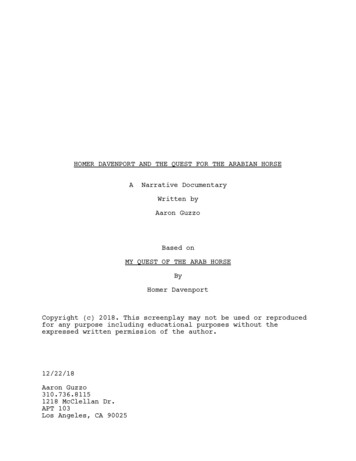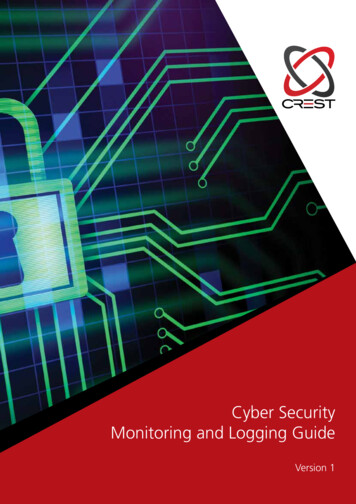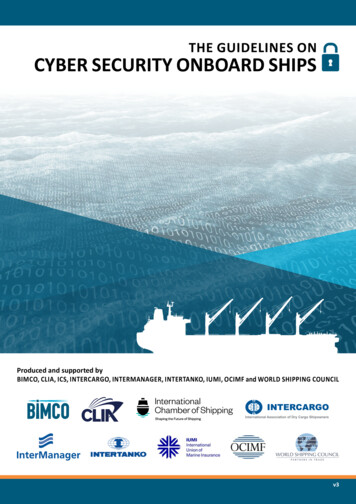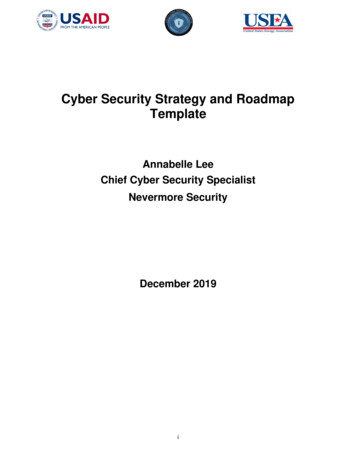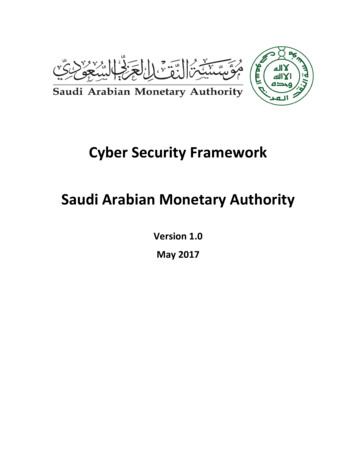
Transcription
Cyber Security FrameworkSaudi Arabian Monetary AuthorityVersion 1.0May 2017
ForewordIn view of the ever-growing seriousness of cyber-attacks, we are conscious of the need to stay one-stepahead. The issuance of a Cyber Security Framework (“Framework”) seeks to support our regulated entitiesin their efforts to have an appropriate cyber security governance and to build a robust infrastructure alongwith the necessary detective and preventive controls. The Framework articulates appropriate controlsand provide guidance on how to assess maturity level.The adoption and implementation of the Framework is a vital step for ensuring that Saudi ArabianBanking, Insurance and Financing Companies sectors can manage and withstand cyber security threats. Indesigning the Framework, we have considered the ways that our regulated entities are leveragingtechnology and felt that each entity will be able to adopt a common approach for addressing cybersecurity. This will ensure cyber security risks are properly managed throughout the sectorsTo achieve the above, the full support and oversight from the Board of Directors and SeniorManagement are required for its implementation.The Information Technology Risk team within the Deputyship of Supervision is at your disposal for anyclarifications and we remain committed to guiding our regulated entities in creating a safer cyberenvironment.Ahmed Al SheikhDeputy Governor for SupervisionVersion 1.0Page 2 of 56
Contents123Introduction . 51.1Introduction to the Framework . 51.2Definition of Cyber Security . 51.3Scope . 61.4Applicability. 61.5Responsibilities . 71.6Interpretation. 71.7Target Audience . 71.8Review, Updates and Maintenance . 71.9Reading Guide . 7Framework Structure and Features . 82.1Structure . 82.2Principle-based. 92.3Self-Assessment, Review and Audit . 92.4Cyber Security Maturity Model. 102.4.1Maturity Level 3 . 102.4.2Maturity Level 4 . 112.4.3Maturity Level 5 . 12Control domains . 133.1Cyber Security Leadership and Governance . 133.1.1Cyber Security Governance . 133.1.2Cyber Security Strategy . 143.1.3Cyber Security Policy . 143.1.4Cyber Security Roles and Responsibilities. 153.1.5Cyber Security in Project Management . 173.1.6Cyber Security Awareness. 173.1.7Cyber Security Training . 183.2Cyber Security Risk Management and Compliance . 193.2.1Cyber Security Risk Management . 193.2.2Regulatory Compliance . 223.2.3Compliance with (inter)national industry standards . 223.2.4Cyber Security Review. 22Version 1.0Page 3 of 56
3.2.53.3Cyber Security Audits . 23Cyber Security Operations and Technology . 243.3.1Human Resources . 243.3.2Physical Security. 243.3.3Asset Management . 253.3.4Cyber Security Architecture . 253.3.5Identity and Access Management. 263.3.6Application Security . 273.3.7Change Management . 273.3.8Infrastructure Security . 283.3.9Cryptography. 293.3.10Bring Your Own Device (BYOD) . 303.3.11Secure Disposal of Information Assets . 303.3.12Payment Systems . 313.3.13Electronic Banking Services . 313.3.14Cyber Security Event Management . 333.3.15Cyber Security Incident Management . 333.3.16Threat Management . 343.3.17Vulnerability Management . 353.4Third Party Cyber Security . 363.4.1Contract and Vendor Management . 363.4.2Outsourcing . 373.4.3Cloud Computing . 37Appendices . 39Appendix A - Overview previous issued SAMA circulars . 40Appendix B - How to request an Update to the Framework . 41Appendix C – Framework Update request form . 42Appendix D - How to request a Waiver from the Framework . 43Appendix E – Framework Waiver request form . 44Appendix F - Glossary. 45Version 1.0Page 4 of 56
1Introduction1.1 Introduction to the FrameworkThe current digital society has high expectations of flawless customer experience, continuous availabilityof services and effective protection of sensitive data. Information assets and online services are nowstrategically important to all public and private organizations, as well as to broader society. These servicesare vital to the creation of a vibrant digital economy. They are also becoming systemically important tothe economy and to broader national security. All of which underlines the need to safeguard sensitivedata and transactions, and thereby ensure confidence in the overall Saudi Financial Sector.The stakes are high when it comes to the confidentiality, integrity and availability of information assets,and applying new online services and new developments (e.g. Fintech, block chain); while improvingresilience against cyber threats. Not only is the dependency on these services growing, but the threatlandscape is rapidly changing. The Financial Sector recognizes the rate at which the cyber threats and risksare evolving, as well as the changing technology and business landscape.SAMA established a Cyber Security Framework (“the Framework”) to enable Financial Institutionsregulated by SAMA (“the Member Organizations”) to effectively identify and address risks related to cybersecurity. To maintain the protection of information assets and online services, the Member Organizationsmust adopt the Framework.The objective of the Framework is as follows:1. To create a common approach for addressing cyber security within the Member Organizations.2. To achieve an appropriate maturity level of cyber security controls within the Member Organizations.3. To ensure cyber security risks are properly managed throughout the Member Organizations.The Framework will be used to periodically assess the maturity level and evaluate the effectiveness of thecyber security controls at Member Organizations, and to compare these with other MemberOrganizations.The Framework is based on the SAMA requirements and industry cyber security standards, such as NIST,ISF, ISO, BASEL and PCI.The Framework supersedes all previous issued SAMA circulars with regard to cyber security. Please referto ‘Appendix A – Overview previous issued SAMA circulars’ for more details.1.2 Definition of Cyber SecurityCyber security is defined as the collection of tools, policies, security concepts, security safeguards,guidelines, risk management approaches, actions, training, best practices, assurance, and technologiesthat can be used to protect the member organization's information assets against internal and externalthreats.The general security objectives comprise the following: Confidentiality – Information assets are accessible only to those authorized to have access (i.e.,protected from unauthorized disclosure or (un)intended leakage of sensitive data).Version 1.0Page 5 of 56
Integrity – Information assets are accurate, complete and processed correctly (i.e., protected fromunauthorized modification, which may include authenticity and non-repudiation).Availability – Information assets are resilient and accessible when required (i.e., protected fromunauthorized disruption).1.3 ScopeThe Framework defines principles and objectives for initiating, implementing, maintaining, monitoringand improving cyber security controls in Member Organizations.The Framework provides cyber security controls which are applicable to the information assets of theMember Organization, including: Electronic information.Physical information (hardcopy).Applications, software, electronic services and databases.Computers and electronic machines (e.g., ATM).Information storage devices (e.g., hard disk, USB stick).Premises, equipment and communication networks (technical infrastructure).The Framework provides direction for cyber security requirements for Member Organizations and itssubsidiaries, staff, third parties and customers.For business continuity related requirements please refer to the SAMA Business Continuity MinimumRequirements.The Framework has an interrelationship with other corporate policies for related areas, such as physicalsecurity and fraud management. This framework does not address the non-cyber security requirementsfor those areas.1.4 ApplicabilityThe Framework is applicable to all Member Organizations regulated by SAMA, which include thefollowing: All Banks operating in Saudi Arabia;All Insurance and/or Reinsurance Companies operating in Saudi Arabia;All Financing Companies operating in Saudi Arabia;All Credit Bureaus operating In Saudi Arabia;The Financial Market InfrastructureAll domains are applicable for the banking sector. However, for other financial institutions the followingexceptions apply: Version 1.0Sub-domain (3.1.2) the alignment with cyber security strategy of banking sector is mandatorywhen applicable.Exclude sub-domain (3.2.3). However, if the organization store, process or transmit cardholderdata or deal with SWIFT services, then PCI standard and/or SWIFT Customer Security ControlsFramework should be implemented.Exclude sub-domain (3.3.12).Page 6 of 56
Exclude sub-domain (3.3.13). However, if the organization provides online services for customers,a Multi Factor Authentication capability should be implemented.1.5 ResponsibilitiesThe framework is mandated by SAMA. SAMA is the owner and is responsible for periodically updating theFramework.The Member Organizations are responsible for adopting and implementing the Framework.1.6 InterpretationSAMA, as the owner of the Framework, is solely responsible for providing interpretations of the principles,objectives and control considerations, if required.1.7 Target AudienceThe Framework is intended for senior and executive management, business owners, owners ofinformation assets, CISOs and those who are responsible for and involved in defining, implementing andreviewing cyber security controls within the Member Organizations.1.8 Review, Updates and MaintenanceThe Framework will be reviewed and maintained by SAMA.SAMA will review the Framework periodically to determine the Framework’s effectiveness, including theeffectiveness of the Framework to address emerging cyber security threats and risks. If applicable, SAMAwill update the Framework based on the outcome of the review.If a Member Organization considers that an update to the Framework is required, the MemberOrganization should formally submit the requested update to SAMA. SAMA will review the requestedupdate, and when approved, the Framework will be adjusted.The Member Organization will remain responsible to be compliant with the Framework pending therequested update.Please refer to ‘Appendix B – How to request an Update to the Framework’ for the process of requestingan update to the Framework.Version control will be implemented for maintaining the Framework. Whenever any changes are made,the preceding version shall be retired and the new version shall be published and communicated to allMember Organizations. For the convenience of the Member Organizations, changes to the Frameworkshall be clearly indicated.1.9 Reading GuideThe Framework is structured as follows. Chapter 2 elaborates on the structure of the Framework, andprovides instructions on how to apply the Framework. Chapter 3 presents the actual Framework, includingthe cyber security domains and subdomains, principles, objectives and control considerations.Version 1.0Page 7 of 56
2Framework Structure and Features2.1 StructureThe Framework is structured around four main domains, namely: Cyber Security Leadership and Governance.Cyber Security Risk Management and Compliance.Cyber Security Operations and Technology.Third Party Cyber Security.For each domain, several subdomains are defined. A subdomain focusses on a specific cyber security topic.Per subdomain, the Framework states a principle, objective and control considerations. A principle summarizes the main set of required cyber security controls related to the subdomain.The objective describes the purpose of the principle and what the set of required cyber securitycontrols are expected to achieve.The control considerations reflects the mandated cyber security controls that should be considered.Control considerations have been uniquely numbered throughout the Framework. Where applicable, acontrol consideration can consist of up to 4 levels.The control considerations are numbered according to the following numbering system:Figure 1 – Control consideration numbering systemVersion 1.0Page 8 of 56
The figure below illustrates the overall structure of the Framework and indicates the cyber securitydomains and subdomains, including a reference to the applicable section of the Framework.Figure 2 - Cyber Security Framework2.2 Principle-basedThe Framework is principle based, also referred to as risk based. This means that it prescribes key cybersecurity principles and objectives to be embedded and achieved by the Member Organization. The list ofmandated control considerations provides additional direction and should be considered by the MemberOrganization in achieving the objectives. When a certain control consideration cannot be tailored orimplemented, the Member Organization should consider applying compensating controls, pursuing aninternal risk acceptance and requesting a formal waiver from SAMA.Please refer to Appendix D for details for the – How to request a Waiver from the Framework – process.2.3 Self-Assessment, Review and AuditThe implementation of the Framework at the Member Organization will be subject to a periodic selfassessment. The self-assessment will be performed by the Member Organization based on aquestionnaire. The self-assessments will be reviewed and audited by SAMA to determine the level ofcompliance with the Framework and the cyber security maturity level of the Member Organization.Please refer to ’2.4 Cyber Security Maturity Model’ for more details about the cyber security maturitymodel.Version 1.0Page 9 of 56
2.4 Cyber Security Maturity ModelThe cyber security maturity level will be measured with the help of a predefined cyber security maturitymodel. The cyber security maturity model distinguishes 6 maturity levels (0, 1, 2, 3, 4 and 5), which aresummarized in the table below. In order to achieve levels 3, 4 or 5, a Member Organization must firstmeet all criteria of the preceding maturity levels.Maturity Level0Non-existent1Ad-hoc2Repeatablebut informal3Structuredandformalized4Managed andmeasurableDefinition and CriteriaExplanation No documentation. There is no awareness or attention for certain cybersecurity control. Cyber security controls is not or partially defined. Cyber security controls are performed in an inconsistentway. Cyber security controls are not fully defined. The execution of the cyber security control is based on an informal and unwritten, thoughstandardized, practice. Cyber security controls are not in place. There may be noawareness of the particular risk area or no current plansto implement such cyber security controls. Cyber security control design and execution varies bydepartment or owner. Cyber security control design may only partially mitigatethe identified risk and execution may be inconsistent. Repeatable cyber security controls are in place. However,the control objectives and design are not formally definedor approved. There is limited consideration for a structured review ortesting of a control. Cyber security policies, standards and procedures areestablished. Compliance with cyber security documentation i.e.,policies, standards and procedures is monitored,preferably using a governance, risk and compliance tool(GRC). key performance indicators are defined, monitored andreported to evaluate the implementation. Effectiveness of cyber security controls are measured andperiodically evaluated. key risk indicators and trend reporting are used todetermine the effectiveness of the cyber securitycontrols. Results of measurement and evaluation are used toidentify opportunities for improvement of the cybersecurity controls. The enterprise-wide cyber security program focuses oncontinuous compliance, effectiveness and improvementof the cyber security controls. Cyber security controls are integrated with enterprise riskmanagement framework and practices. Performance of cyber security controls are evaluatedusing peer and sector data. Cyber security controls are defined, approved andimplemented in a structured and formalized way. The implementation of cyber security controls can bedemonstrated. The effectiveness of the cyber security controls areperiodically assessed and improved when necessary. s for improvement are documented. Cyber security controls are subject to a continuousimprovement plan.5AdaptiveTable 1 - Cyber Security Maturity ModelThe objective of the Framework is to create an effective approach for addressing cyber security andmanaging cyber security risks within the Financial Sector. To achieve an appropriate cyber securitymaturity level, the Member Organizations should at least operate at maturity level 3 or higher asexplained below.2.4.1 Maturity Level 3To achieve level 3 maturity, a Member Organization should define, approve and implement cybersecurity controls. In addition, it should monitor compliance with the cyber security documentation .The cyber security documentation should clearly indicate “why”, “what” and “how” cyber securitycontrols should be implemented. The cyber security documentation consists of cyber security policies,cyber security standards and cyber security procedures.Version 1.0Page 10 of 56
Figure 3 - Cyber Security Documentation PyramidThe cyber security policy should be endorsed and mandated by the board of the Member Organizationand stating “why” cyber security is important to the Member Organization. The policy should highlightwhich information assets must be protected and “what” cyber security principles and objectives shouldbe established.Based on the cyber security policy, cyber security standards must be developed. These standards define“what“ cyber security controls must be implemented, such as security and system parameters,segregation of duties, password rules, monitoring events and back-up and recovery rules. The standardssupport and reinforce the cyber security policy and are to be considered as cyber security baselines.The step-by-step tasks and activities that should be performed by staff, third parties or customers of theMember Organization are detailed in the cyber security procedures. These procedures prescribe “how”the cyber security controls, tasks and activities have to be executed in the operating environment andsupport the safeguarding of the information assets of the Member Organization according to the cybersecurity policy and standards.The process in the context of this framework is defined as a structured set of activities designed toaccomplish the specified objective. A process may include policies, standards, guidelines, procedures,activities and work instructions, as well as any of the roles, responsibilities, tools and managementcontrols required to reliably deliver the output.The actual progress of the implementation, performance and compliance of the cyber security controlsshould be periodically monitored and evaluated using key performance indicators (KPIs).2.4.2 Maturity Level 4To achieve maturity level 4, the Member Organization should periodically measure and evaluate theeffectiveness of implemented cyber security controls. In order to measure and evaluate whether the cyberVersion 1.0Page 11 of 56
security controls are effective, key risk indicators (KRIs) should be defined. A KRI indicates the norm foreffectiveness measurement and should define thresholds to determine whether the actual result ofmeasurement is below, on, or above the targeted norm. KRIs are used for trend reporting andidentification of potential improvements.2.4.3 Maturity Level 5Maturity level 5 focuses on the continuous improvement of cyber security controls. Continuousimprovement is achieved through continuously analyzing the goals and achievements of cyber securityand identifying structural improvements. Cyber security controls should be integrated with enterprise riskmanagement practices and supported with automated real-time monitoring. Business process ownersshould be accountable for monitoring the compliance of the cyber security controls, measuring theeffectiveness of the cyber security controls and incorporating the cyber security controls within theenterprise risk management framework . Additionally, the performance of cyber security controls shouldbe evaluated using peer and sector data.Version 1.0Page 12 of 56
3 Control domains3.1 Cyber Security Leadership and GovernanceThe ultimate responsibility for cyber security rests with the board of the Member Organization. The boardof the Member Organization can delegate its cyber security responsibilities to a cyber security committee(or a senior manager from a control function). The cyber security committee could be responsible fordefining the cyber security governance and setting the Member Organization’s cyber security strategy.The cyber security committee can also be responsible for defining a cyber security policy and ensuring theoperational effectiveness of this cyber security policy.To develop and maintain the cyber security policy and to execute the cyber security activities across theMember Organization, an independent cyber security function should be established.3.1.1 Cyber Security GovernancePrincipleA cyber security governance structure should be defined and implemented, and should be endorsed bythe board.ObjectiveTo direct and control the overall approach to cyber security within the Member Organization.Control considerations1. A cyber security committee should be established and be mandated by the board.2. The cyber security committee should be headed by an independent senior manager from a controlfunction.3. The following positions should be represented in the cyber security committee:a. senior managers from all relevant departments (e.g., COO, CIO, compliance officer, heads ofrelevant business departments);b. Chief information security officer (CISO);c. Internal audit may attend as an “observer.4. A cyber security committee charter should be developed, approved and reflect:a. committee objectives;b. roles and responsibilities;c. minimum number of meeting participants;d. meeting frequency (minimum on quarterly basis).5. A cyber security function should be established.6. The cyber security function should be independent from the information technology function. Toavoid any conflict of interest, the cyber security function and information technology function shouldhave separate reporting lines, budgets and staff evaluations.7. The cyber security function should report directly to the CEO/managing director of the MemberOrganization or general manager of a control function.8. A full-time senior manager for the cyber security function, referred to as CISO, should be appointedat senior management level.9. The Member Organization should :a. ensure the CISO has a Saudi nationality;b. ensure the CISO is sufficiently qualified;Version 1.0Page 13 of 56
c. obtain no objection from SAMA to assign the CISO.10. The board of the Member Organization should allocate sufficient budget to execute the requiredcyber security activities.3.1.2 Cyber Security StrategyPrincipleA cyber security strategy should be defined and aligned with the Member Organization’s strategicobjectives, as well as with the Banking Sector’s cyber security strategy.ObjectiveTo ensure that cyber security initiatives and projects within the Member Organization contribute to theMember Organization’s strategic objectives and are aligned with the Banking Sector’s cyber securitystrategy.Control considerations1. The cyber security strategy should be defined, approved, maintained and executed.2. The cyber security strategy should be aligned with:a. the Member Organization’s overall objectives;b. the legal and regulatory compli
The Framework will be used to periodically assess the maturity level and evaluate the effectiveness of the cyber security controls at Member Organizations, and to compare these with other Member Organizations. The Framework is based on the SAMA requirements and industry cyber security standards, such as NIST, ISF, ISO, BASEL and PCI.


